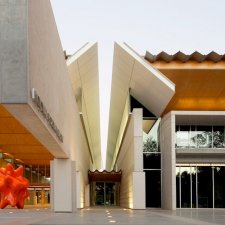- About us
- Support the Gallery
- Venue hire
- Publications
- Research library
- Organisation chart
- Employment
- Contact us
- Make a booking
- Onsite programs
- Online programs
- School visit information
- Learning resources
- Little Darlings
- Professional learning
The painter, etcher, sculptor and textile designer Paule Vézelay was a pioneer of twentieth-century abstract art. Born in Bristol, she studied art there and at the Slade School of Fine Art and the London School of Art, and held her first solo exhibition in London in 1921. Several followed thereafter throughout the 1920s and 1930s. ‘English art then bored me to tears,’ she declared in a 1984 BBC interview with the feminist writer Germaine Greer. Attracted by the avant-garde artistic developments then unfolding in Paris, she settled there in 1926 and changed her name from Marjorie Watson-Williams to Paule Vézelay.
The bold, simplified forms of this self portrait manifest a transition from her earlier, impressionistic style towards more experimental work involving surrealist imagery and abstract shapes. In 1934, she became a member of the group Abstraction-Création, where she continued to develop her pioneering abstract style. Vézelay became one of the first British artists to abandon figuration entirely, but her contribution to the development of abstract art was largely overlooked until the 1980s.
National Portrait Gallery, London
Purchased, 1988
© National Portrait Gallery, London



Visit us, learn with us, support us or work with us! Here’s a range of information about planning your visit, our history and more!



We depend on your support to keep creating our programs, exhibitions, publications and building the amazing portrait collection!



Information on location, accessibility and amenities.